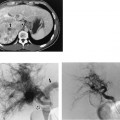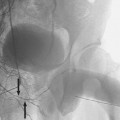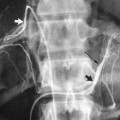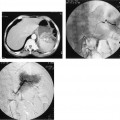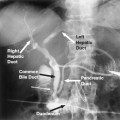12
Radiation Protection
Persons who work in the interventional radiology suite have the potential for receiving a relatively high radiation dose as a result of diagnostic and interventional procedures that may require relatively long fluoroscopy exposure times. This section reviews the principles of radiation protection specific to the angiosuite that will minimize the exposure to the patient and the radiologist. With careful attention to technology and the use of proper fluoroscopy and personal protective equipment, radiation exposure can be kept to well within accepted limits.
 Radiation Units and Dose Limits
Radiation Units and Dose Limits
The measurement of radiation is based on its ability to ionize air. The units used to measure radiation are numerous and usually are expressed in both the older, more familiar “conventional” system and the newer International System of Units (SI). For diagnostic x-rays, the units used most often are the roentgen (R), radiation absorbed dose (rad), Gray (Gy), and Sievert (Sv). For absorption of x-rays in soft tissue, a rule of thumb is
1 R ≍ 1 rad = 10 mGy = 10 mSv
The National Council on Radiation Protection and Measurements (NCRP),1 a nonprofit corporation chartered by the U.S. Congress in 1964 to provide expertise and guidance with regard to radiation, currently recommends an annual dose limit for occupational exposure of 50 mSv (5 rem) and a cumulative dose limit, in mSv, of 10 × the person’s age (in years)(Table 12-1).
The annual dose limit recommended by the NCRP assumes a uniform irradiation of the individual person’s body. In situations where this is not the case, the concept of the effective dose (E) is introduced, which has associated with it the same probability of the occurrence of cancer and genetic effects whether received by the whole body by uniform irradiation or by partial body or individual organ irradiation. In the case of partial body irradiation, if the dose received by different organs is known, the effective dose can be calculated by multiplying each organ dose by the appropriate weighting factor and then summing these values:
E = Σ1 (organ dose)1 × (weighting factor) 1
with I, irradiation (Table 12-2). Note that there is no longer a separate dose limit for the thyroid because it is incorporated into the effective dose.
Occupational doses are measured by personnel monitors such as film badges or thermoluminescent detectors. At a minimum, a single monitor should be worn outside the lead apron at collar level to monitor the thyroid and eye lens doses. The use of a second monitor, worn under the apron at waist level, is recommended for a more accurate determination of the effective dose and should be mandatory for pregnant personnel. A finger dosimeter should be worn if the individual’s hands will be exposed to the primary x-ray beam.
It should be noted that a relatively high reading of the dosimeter worn outside the apron at the neck does not represent the effective dose. The NCRP recommends that the effective dose E can be estimated by the formulas, E = 0.5 HW + 0.025 HN when two monitors are worn and by E = (HN /21) for a single monitor,2 where HW and HN are the recorded values of the monitors under the apron and outside the apron at the neck, respectively.
| Dose Limit | ||
| Exposures | mSv | (rem) |
| Occupational Effective dose limits | ||
| Annual | 50 | (5) |
| Cumulative | 10 × Age (yrs) | [1 × Age (yrs)] |
| Equivalent dose annual limits for tissues and organs | ||
| Lens of eye | 150 | (15) |
| Skin, hands, and feet | 500 | (50) |
| Members of the Public (annual) | ||
| 1. Effective dose limit, continuous or frequent exposure | 1.0 | (0.1) |
| 2. Effective dose limit, infrequent exposure | 5.0 | (0.5) |
| 3. Equivalent dose limits for tissues and organs | ||
| Lens of eye | 15 | (1.5) |
| Skin, hands, and feet | 50 | (5) |
| Embryo-fetus (monthly) | ||
| Equivalent dose limit | 0.5 | (0.05) |
One study, which involved 28 interventional radiologists from 17 institutions who performed an average of 972 interventional procedures per year, calculated the effective dose from the personnel dosimetry readings of these persons using tables of weighting factors, organ doses, and depth dose charts.3 The average yearly estimate of the collar and under apron badges for this group was 48.0 mSv (4.80 rem) and 0.88 mSv (88 mrem), respectively. Conversion of these badge readings to mean annual effective dose resulted in a value of 3.16 mSv (316 mrem), substantially less than the annual limit of 50 mSv. The authors also found that Webster’s formula for effective dose from two personnel monitors, HE =1.5 HW + 0.04 HN, overestimates the effective dose by 70% for those who wear a thyroid shield but underestimates the value by 21% for those who do not wear a shield.
Personnel dosimeters always should be kept in a radiation-free area when not in use. If film badges are left on a lead apron hanging inside the room, they may be exposed to scatter during interventional cases, or they may accidentally be worn by another staff member.
| Tissue or Organ | Weighting Factor |
| Bone surface, skin | 0.01 |
| Bladder, breast, liver, esophagus, thyroid, remainder a | 0.05 |
| Bone marrow, colon, lung, stomach | 0.12 |
| Gonads | 0.20 |
| a The remainder includes adrenals, brain, small intestine, large intestine, kidney, muscle, pancreas, spleen, thymus, and uterus. |
Stay updated, free articles. Join our Telegram channel

Full access? Get Clinical Tree



